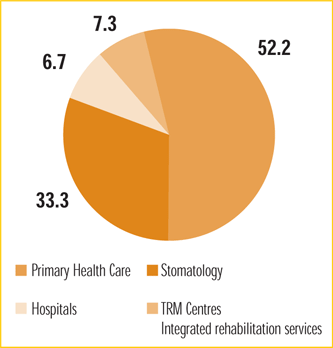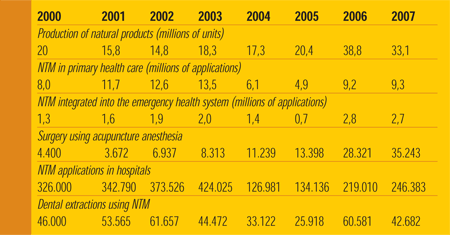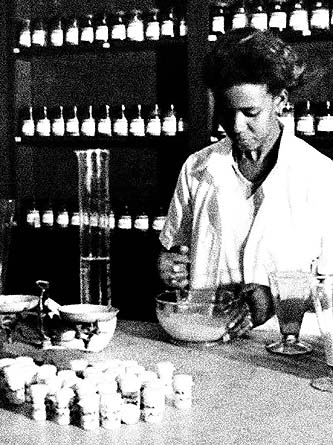Integrating the practice of traditional and natural medicine into the health system
Results
Cuba's biggest success in recent years is the gradual and stable integration of traditional medical resources into community services both in terms of secondary, and more importantly, primary health care, which makes this a unique experience in the American continent. The following pie chart illustrates the result of TRM integration into the Cuban health system:
TRM development centres are specialised facilities within the Cuban health system, providing services to all the country’s provinces and municipalities. All in all, a total of 3,535 new jobs have been created in the 14 provincial TRM centres and municipal centres and intergrated rehabiliation services throughout the country.
There was a turning point in the teaching of medicine in Cuba with the inauguration of the Escuela Latinoamericana de Medicina (ELAM), where young people of different ethnic groups could learn to use the scientific procedures of conventional medicine and at the same time study the traditional medicine of the local population. They also receive full training in the techniques of natural and traditional medicine used in the country. TRM practices preserve cultural traditions and enhance the health system from the institutional, scientific, economic and financial points of view.
Cuba was hit by two hurricanes in 2008, which caused much devastation. A group of homoeopathy and flower essence therapy experts identified which remedies could be administered to the population to achieve rapid psychological and physical recovery. These natural products were administered to approximately 55,000 people.
Bearing in mind the NTM growth indicators for Cuba and figures from the national statistics system for the years 2000-2007 we can trace the development of the following parameters in the table below.
The reserves of natural medical resources throughout the country have been reappraised, studied and put to better use. Moreover, technology for the production of natural medicine has been elaborated. An example of this activity is the work of the mountain laboratories, which process medicinal plants for phytotherapy or herbalism and spa resorts which integrate hot springtherapy and natural medicine.
Acupuncture can be used as an anaesthetic in surgery on patients that are unable to undergo general anaesthetics or where the risk involved in using anaesthetics is too high. In terms of cost, the price of a general endotracheal anaesthetic is USD 215.83 per patient, while the use of acupuncture as a anaesthetic in operations costs USD 19.71. 
The following two examples show the economic benefits to be gained from the use of TRM:
Cuba's experience of using homoeopathy to deal with epidemic outbreaks is positive. An example is the 2006 dengue hemorrhagic fever epidemic. Dengue fever symptoms affect a patient for an average of seven to 10 days. This was reduced to an average of three days in patients who were given homoeopathic treatment, symptoms disappearing completely or becoming very mild, and there were no complications, resulting in a marked improvement in recovery times and less time spent in hospital. Apart from these advantages there are considerable savings economically. A dengue patient who is taken to hospital and given analgesics, antipyretics, venoclysis, antiemetics, oral rehydration salts, daily laboratory tests and medical care for seven days costs approximately 170 pesos a day. If dengue hemorrhagic fever sets in, specialised care is needed, raising costs - 15 days hosptialization at 300 pesos a day.
Using homeopathy to treat dengue hemorrhagic fever patients costs about 120 pesos a day. In short, using homoeopathy to treat this illness saved the country 1,050,000 pesos by way of not having to use allopathic medicine to treat hospital patients. The prevention of possible outbreaks and the administration of homeopathic remedies to the population saved 3,150,000,000 pesos.
DOWNLOAD THE BROCHURE PDF
english (1.1 MB)spanish (1.1 MB)
serbian (0.5 MB)
ONLY TEXT
•Traditional and Natural Medicine in practice
•The employment of Traditional and natural medicine in other countries








 COUNTRY OF ORIGIN
COUNTRY OF ORIGIN